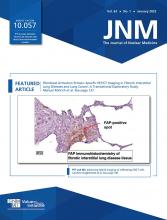TO THE EDITOR: Limited data are available describing the role of 18F-FDG PET/CT in assessing treatment response in pediatric posttransplant lymphoproliferative disease (PTLD). In this journal, Montes de Jesus reported 8 patients who underwent end-of-treatment 18F-FDG PET/CT. Of 4 positive scans, 1 was true-positive and the remaining 3 were false-positive. There were 4 true-negative and 1 false-negative results. In 2 of the false-positive cases, a 2-y follow-up did not reveal PTLD, and in 1 case a biopsy revealed no evidence of PTLD. For the false-negative end-of-treatment 18F-FDG PET/CT, a biopsy 2 mo later revealed residual monomorphic PTLD (1). Similar data were reported in adult PTLD. Van Keerberghen reported positive predictive values (PPVs) and negative predictive values (NPVs) for disease recurrence of 13% and 85% for interim and 33% and 87% for end-of-treatment 18F-FDG PET/CT, respectively. Negative interim or negative end-of-treatment 18F-FDG PET/CT correlated with durable remissions (2). A lower false-positive rate was reported at assessment of treatment response in 20% of cases in a recent metanalysis evaluating the performance of 18F-FDG PET/CT either at interim or end-of-treatment assessments (3).
A 12-y-old with history of heart transplant in infancy presented with bowel obstruction and was found to have an abdominal mass. Tumor biopsy revealed monomorphic PTLD/diffuse large B-cell lymphoma (DLBCL) subtype, Epstein-Barr virus–negative. After 4 cycles of immune-chemotherapy, 18F-FDG PET/CT showed avid uptake in a segment of the small bowel (Deauville 4). Because of the limited data about interpreting a positive end-of-treatment 18F-FDG PET/CT in a child with PTLD, he underwent a biopsy, which was negative for PTLD/DLBCL. This case illustrates the problem of a false-positive uptake on 18F-FDG PET/CT and therefore the limitations of a positive 18F-FDG PET/CT in the assessment of treatment response, similar to the report in this journal (1). In another child, an 8-y-old with Burkitt lymphoma postcardiac transplant, a residual mediastinal mass at end of therapy was 18F-FDG PET/CT–negative; therefore, no biopsy was performed and no further therapy was administered. This child remains in remission 9 mo after the end of therapy. This decision was guided by the relatively high NPV reported by Van Keerberghena and Montes de Jesus (2,3). In a metanalysis by Montes de Jesus, inactive metabolic lesions on 18F-FDG PET/CT were considered to be in complete remission. Treatment was stopped in half of the cases to minimize treatment-related complications. Patients in whom treatment was stopped remained in complete remission throughout the study follow-up (3).
In pediatric non-Hodgkin lymphoma (NHL), a high NPV was reported in 2 studies (4,5). This remains to be studied further in patients with post–solid organ transplant Burkitt lymphoma (PSOT-BL), as in our second patient. Post solid organ transplant Burkitt lymphoma is considered a separate entity of PTLD and is treated similarly to Burkitt lymphoma in immunocompetent children. This raises an important point concerning the clinical and pathologic spectrum of pediatric PTLD and the implications this variability may have on the metabolic response by 18F-FDG PET/CT based on the subtype of PTLD. Even in studies of pediatric NHL, a high false-positive rate was reported. In the study by Minard et al., only 2 of 26 patients who underwent biopsy, after chemotherapy, for positive 18F-FDG PET/CT had evidence of residual lymphoma. None of the 62 patients with negative 18F-FDG PET/CT had viable cells at biopsy, and none experienced relapse (4). In a study of 18 children with NHL who underwent 18F-FDG PET to assess treatment response, the sensitivity and NPV were 100%, but the specificity and PPV were 60% and 25%, respectively (5).
The question is: what is the value of 18F-FDG PET/CT in assessing treatment response and identifying true-positive residual PTLD? The limited data available indicate low sensitivity and a high false-positive rate (1–3). Therefore, as a screening tool for response assessment, 18F-FDG PET/CT appears to have limited value in identifying true-positive residual disease in pediatric PTLD. The value of performing 18F-FDG PET/CT to assess treatment response is its high specificity and its ability to predict true-negative residual PTLD.
- © 2022 by the Society of Nuclear Medicine and Molecular Imaging.







